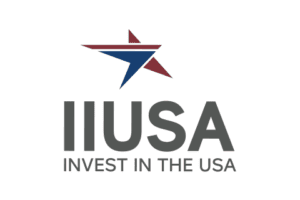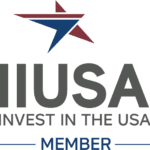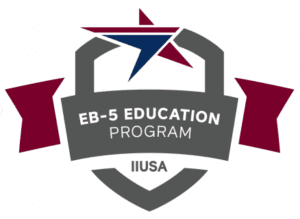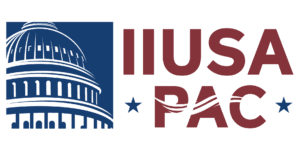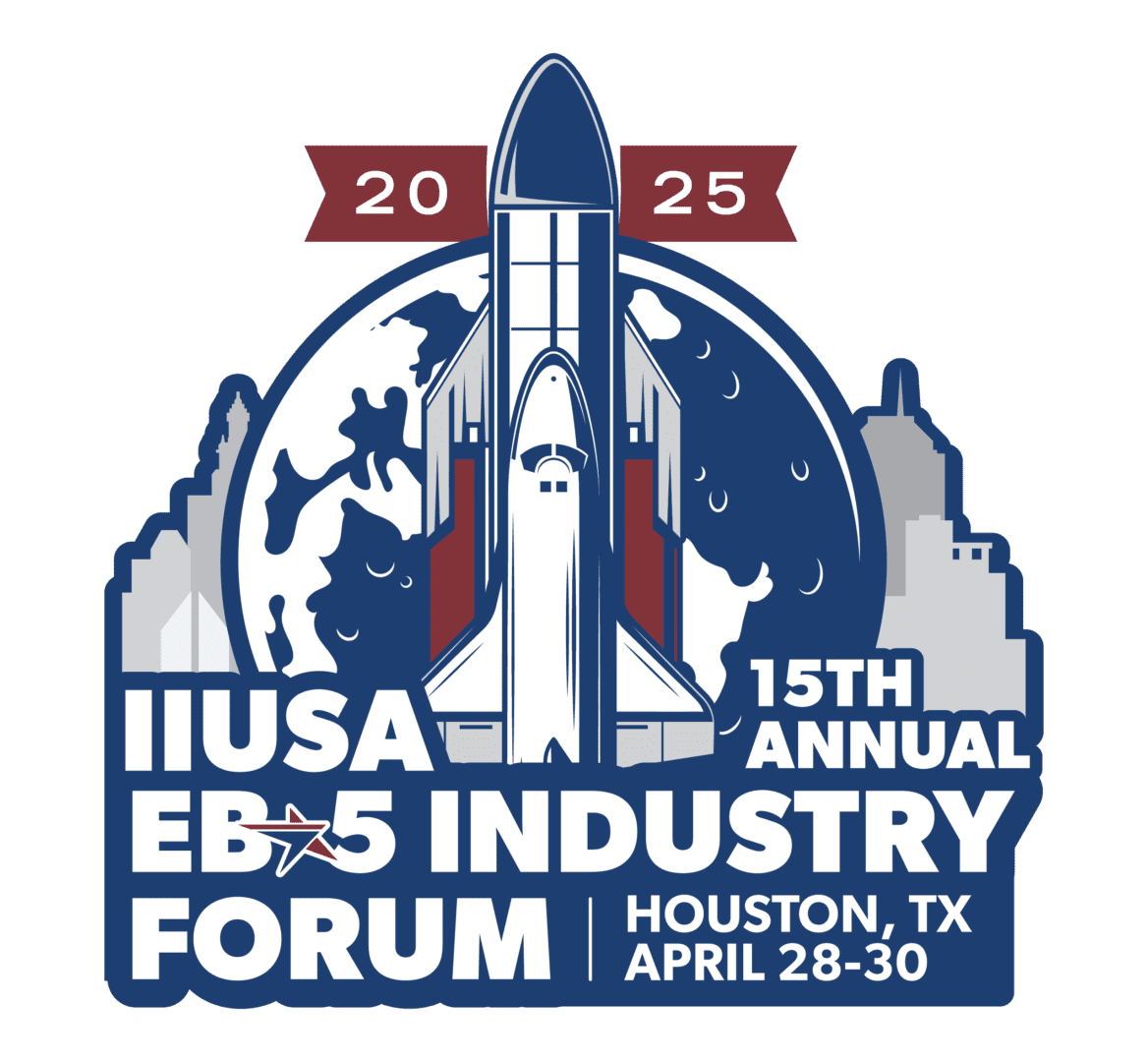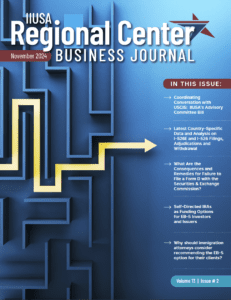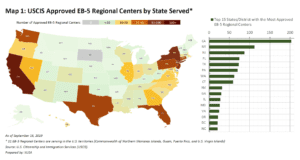
IIUSA Executive Director Peter D. Joseph greets USCIS EB-5 Program Chief Nicolas Colucci following his remarks to the EB-5 Stakeholder Community at the IIUSA EB-5 Regional Economic Development Advocacy Conference on May 8th, 2014 in Washington, D.C.
On May 8th, U.S. Citizenship and Immigration Service (USCIS) Immigrant Investor Program Chief Nicholas Colucci delivered a 20-minute prepared speech and held a short Q & A with EB-5 stakeholders at the IIUSA EB-5 Regional Economic Development Advocacy Conference in Washington, D.C. This engagement marked the first time that Mr. Colucci addressed the EB-5 community in person and comes in the wake of two USCIS teleconferences held on the EB-5 Program in February (members: listen here) and April (members: listen here).
Below is a full transcript of Mr. Colucci’s remarks. A full report of IIUSA’s 7th Annual EB-5 Regional Economic Development Advocacy Conference will be made available on the blog next week.
Prepared Remarks of Nicholas Colucci
Chief, Immigrant Investor Program
U. S. Citizenship and Immigration Services
Association To Invest in the United States (IIUSA)
Eb-5 Regional Economic Development Advocacy Conference
May 8, 2014
Washington, D.C.
Good afternoon, and thank you to Executive Director Joseph, the Board of Directors, and the entire IIUSA membership for inviting me to your conference today. I read on your website that IIUSA represents more than 170 regional centers, which account for greater than 95 percent of all the capital formation associated with the Employment-Based Fifth Preference (EB-5 program), and over 195 associate members of the regional center industry, which include attorneys, broker-dealers, consultants, developers, economists, financial advisors, migration intermediaries, etc. Thus, our engagement with stakeholders such as IIUSA offers a unique opportunity for the U.S. Citizenship and Immigration Services (USCIS) to reach many of the stakeholders who have an interest in the program. But they’re not the only reason I’m here today. I’m here because I sincerely hope to continue the meaningful dialogue that exists within the EB-5 stakeholder community, of which we’re all a part.
While I plan to provide a number of program-related updates here today, I also want to spend a little time discussing my background, as it has helped to shape how I plan to lead the program.
I’ve spent more than 20 years in federal government service, with three different Departments, and this experience has provided me with exposure to many geographic regions, business types, and government and non-government programs. It is through these experiences that I’ve developed a better understanding of the positive impacts of collaborative, constructive engagements.
One such example is when I served at ATF, the Bureau of Alcohol, Tobacco, Firearms and Explosives. One of ATF’s main goals as the Federal regulator for several industries is to increase each industry’s rate of compliance with Federal laws and regulations. At ATF, I was associated with developing a program that concentrated on a subset of a particular regulated industry, whose rate of compliance had historically trailed that of other members of the industry.
Specifically, the program called for ATF to do the following three things in an attempt to reach our goal of producing a measurable increase in compliance:
- increase its proactive interaction with the industry subgroup;
- promote transparency with respect to the types of violations being discovered during audits and the steps the industry could take to avoid these violations in the future; and
- dedicate additional resources to auditing these industry members over the next three years.
The results we achieved were dramatic. However, we would not have been able to achieve these results without the involvement and engagement of the industry. At the end of two years, the compliance rates of this industry subgroup had increased significantly. I can confidently state that this could not have happened had ATF developed a program that did not involve that significant outreach component. Because we had an engaged stakeholder, and because we could have honest conversations between the two organizations, we changed the dynamic of the relationship and worked collaboratively towards achieving a common goal. I hope to establish a similar relationship with our stakeholders across the EB-5 community, as we must work together, and have honest conversations to build a stronger and more vibrant program.
A second experience that helped shape how I plan to administer the EB-5 program is an experience I had at FinCEN – the Financial Crimes Enforcement Network, which is the anti-money laundering regulator for US financial institutions. The same week I was appointed FinCEN’s associate director of the Analysis and Liaison Division, the Secretaries of Treasury and Housing and Urban Development held a press conference with the Attorney General to announce the Administration’s “Making Home Affordable” program, which would provide qualifying homeowners a lower interest rate to help them keep their home. They also announced that FinCEN, and specifically the Division that I was leading, would serve to coordinate the Government’s anti-fraud efforts associated with the program.
Through my work on this program, I learned two important things:
- One is the resources that can be brought to bear across the interagency community, particularly in coordination with not-for-profit and other private entities, can be extremely powerful when focused and coordinated; and
- two, that there are very bright individuals out there who spend a lot of time developing ingenious fraud schemes and that they will not hesitate to take advantage of others when they are at their most vulnerable.
With respect to interagency community coordination, at FinCEN we worked with members from the Federal Bureau of Investigation, Secret Service, the Department of Housing and Urban Development’s Office of the Inspector General, the Federal banking regulators, and a host of other Federal, state and local agencies. I met and worked with key players within each of these organizations, and throughout my time at FinCEN, I probably worked with two dozen more Federal agencies. Each agency, as you know, has a specific role and responsibility, and I was able to learn and understand the roles, tools, and sources of information that they could contribute to an effort.
I have begun to develop this same depth of knowledge in the context of the EB-5 program as many agencies intersect with EB-5, whether it is the Securities and Exchange Commission, Immigration and Customs Enforcement, or the Department of Commerce. One of the things I propose to do, and one of the reasons that the program was relocated to Washington, DC, is to facilitate greater interaction among the interagency community. Just as the EB-5 program cannot be successful without your support, we need to build strong partnerships with other Federal agencies who are likewise stakeholders in the program.
Now, with respect to those out there who take advantage of others: I learned quickly at FinCEN that where there is money, there will be fraudsters. In the context of mortgage fraud, I saw families who were struggling to save their homes only to be victimized by someone, usually a part of an organized group, who claimed they could help families remain in their home for an upfront fee of around $3,000. Of course, after the money was paid, help was not provided.
During my five years at FinCEN, we worked with law enforcement, regulators, and industry to combat not only mortgage fraud, but many other types of fraud including, but not limited to income tax refund fraud, health care fraud, and fraud against senior citizens. The one consistent theme is that organized groups follow the money, and when one source would dry up they would develop a fairly sophisticated scheme to go after the next one.
Given the amounts of monies involved in the projects undertaken in the EB-5 program, fraud is something against which we must all be vigilant. USCIS cannot do this on our own. Many times, you will be in the position to hear or see something suspicious or “too good to be true” before we do. In these cases, I ask that you share this information with us through our immigrant investor mailbox at [email protected]. When fraud does occur, as you know, the entire program suffers, so it is imperative to all of us to maintain and strengthen the integrity of the program.
So, to summarize, the three things from my past experience I hope to bring to the program include:
- an active and honest dialogue with our stakeholders;
- a coordinated effort within the interagency community; and
- with the assistance of our stakeholders, to guard against fraud and other transgressions that damage the integrity of the program.
Now, I’d like to take the remainder of the time to provide a few program updates. As I mentioned at my first stakeholder engagement in February, I plan to concentrate my time primarily in three areas:
- building the foundation;
- customer service and transparency;
- and performance and predictability.
With respect to building the foundation, by the end of this month, we hope to have upwards of 75 staff on board. This does not include those individuals from the Office of Chief Counsel and Fraud Detection and National Security, who work with the program. This is an almost 40 percent increase from where we were at the end of February. We also just had a few job announcements close, for experienced and entry-level adjudicators. It remains our goal to be at or exceed 100 staff members by the end of the fiscal year.
In terms of training, we are striving to ensure our staff continues to participate in professional development opportunities. In fact, just last week we provided our staff with a 3-hour block of instruction from the Securities and Exchange Commission. We are also providing two additional training courses in the next month or so – one on business organizations and documents, such as subscription agreements and private placement memorandums, and another on international banking and money laundering. Finally, we are customizing a decision writing course to assist our adjudicators and economists in drafting clear and concise requests for evidence (RFE) and decision letters. All of this will serve to expand the depth and breadth of the knowledge of our workforce and continue to strengthen the program.
With respect to customer service and transparency, we’ve spent a significant amount of time concentrating on this area in the last month or so. Specifically, we’ve begun to update the website each month with current processing times for each of the form types and we will continue to do this on a monthly basis.
We’ve also recently created a customer service team to respond to inquiries that come to us via the immigrant investor mailbox and service request management tickets, which stakeholders can create themselves online or have created for them by our customer help line. I am proud to state we are ahead of agency standards in our responses to these inquiries.
Finally, we are also seeking a new platform to receive and respond to customer service inquiries, as the mailbox does not lend itself to monitoring for trend and other types of analysis. With this type of information, I’m confident that we will be better able to determine what type of updates and suggestions we can provide to our stakeholders proactively, in an effort to reduce the number of inquiries we receive, thus freeing up more time to adjudicate cases, while providing the best possible service to our customers.
We recently held our second stakeholder engagement since the end of February. At this engagement we asked stakeholders to express their thoughts and input regarding potential EB-5 regulatory changes for USCIS to consider. More than 700 individuals participated and we were able to hear thoughts and feedback from a number of them. We also invited stakeholders to express their ideas and thoughts via a new online tool, called the USCIS Idea Community. More than two dozen individuals provided comments and greater than 200 votes were cast on these comments. We would like to thank those shared their thoughts through the Idea Community.
Finally, in an effort to increase transparency, we are beginning to frame out an annual report beginning in fiscal year 14. My hope is to provide the report sometime around the end of this calendar year.
Now, to address performance and predictability. As I announced in February, I expected to start seeing reduced processing times for regional center applications. In fact, we are starting to see them trend this way. January’s processing time for Form I-924, Application for Regional Center Under the Immigrant Investor Program, was 12 months, and the most recent report, which is March, indicated it has been reduced to around 10 and a half. It is clear that our economists are becoming more efficient and I expect we will see additional improvements in processing times in the coming months.
Similarly, we are seeing progress in the area of Form I-829, Petition by Entrepreneur to Remove Conditions. Our processing time, as you may have seen in our website, has been reduced to about 9 months from more than 11 in January. As you may recall, Form I-829 will be worked in the California Service Center for the remainder of the fiscal year. We will begin to transition this workload to the Immigrant Investor Program Office in Washington, D.C. in July, with a complete handover expected to take place on October 1.
The news is not as good for FormI-526, Immigrant Petition by Alien Entrepreneur. In January, we were around 10 months, and the latest data I have through March indicates we are at a little over 13 months. However, I believe we will soon begin to make progress in this workload as well. In recent weeks we’ve hired a number of adjudicators and we are in the process of hiring another round. We’ve also taken steps to increase the efficiency of our training program for new adjudicators who have previous USCIS experience. In fact, we’ve now begun to certify experienced adjudicators to work on 526s in a matter for 4 to 6 weeks, whereas in the past, it took longer than 2 months.
While ensuring quality, we are working diligently to have our actions equal or exceed the number of receipts each week, and this month I have set an office-wide goal to do this. I can assure you that we are committed to achieving additional efficiencies within the I-526 work and that our staff are aware of the fact that the number of pending petitions equals billions of dollars that will potentially be invested in in the American economy and create tens of thousands of jobs for qualified American workers. They are also aware that this means that thousands of families are checking their mailboxes each day waiting to see if their petition has been approved so they can participate in the American dream. Please know we take our responsibility seriously and we are working with a sense of urgency to move through these petitions.
Finally, before I close, one of the other things we are doing to help increase productivity and predictability is analyzing the RFEs we’ve issued. By sharing this information with all of you, likely via our annual report, our hope is that it will assist you in avoiding potential RFEs as you assemble new applications and petitions.
I’d like to share one such topic to begin this dialogue. As you know, USCIS has and will continue to rely on a variety of economic models and reasonable methodologies (like feasibility studies) to establish by a preponderance of the evidence that a project of a job creating entity will create a sufficient number of indirect jobs for the immigrant investors in that project. USCIS currently reviews economic impact analyses that use the results of economic modeling software such as IMPLAN, REMI, and REDYN to establish the number of indirect jobs created by the job creating entity. And while USCIS recognizes that these modeling platforms are valid economic modeling systems for estimating job creation, as you know, the burden of proof is on the applicant or petitioner to clearly explain the inputs used in the model and to demonstrate the mechanism of job creation.
Please note that jobs with a duration of less than 24 months are not eligible to be counted for EB-5 purposes. Nor are jobs from transactional expenses, for example attorney’s fees for closing costs. Also, please note that transfers or transfer payments are not eligible expenses for job creation. Transfer payments like taxes, insurance premiums, permits and fees are classified by economists as redistributions and not activities that create output. So, while EB-5 investor funds can be used to pay all legitimate business expenses, not all business expenses can be used in job creation calculations. Therefore, the economic models should provide an explanation of the inputs used and show that ineligible expenses and transfers are not included in job creation calculations.
One common reason for an RFE relating to the economic modeling analysis relates to direct versus indirect jobs. As you know, USCIS regulations refer to direct jobs as those at the new commercial enterprise; however, economic models distinguish direct job and indirect jobs differently. With respect to the economic models, direct jobs refer to jobs directly related to the project. For example, construction jobs for a project are often considered “direct jobs” in the economic analysis and may be credited toward the EB-5 requirement if the jobs are expected to last at least 2 years.
Any economic analysis based upon models such as IMPLAN, REMI, or REDYN must be sufficiently transparent to allow USCIS to distinguish between the model’s calculation of direct and indirect jobs. If the model used in an economic impact analysis aggregates direct and indirect jobs, the economist preparing the analysis for the regional center should demonstrate how the model’s result can be disaggregated into its direct and indirect jobs components. This may involve running the model twice: once to calculate direct effects and once to calculate the indirect and induced effects. In most cases a narrative by the economist preparing the analysis that explains how direct and indirect jobs can be derived from the aggregate job total is sufficient.
Additionally, the economist preparing the analysis for the regional center should provide the number of direct and indirect jobs created that is attributable to each of the model’s inputs. For example, differentiating the jobs created from construction expenditures from those created from the ongoing operations of the property constructed. In addition, USCIS recognizes that indirect jobs that are estimated through use of an economic model and are located outside of the geographical boundaries of a regional center may qualify if the economic methodology is reasonable.
I hope that by sharing this example, which will be included with the rest of my comments on our website, we can begin to inform you how we evaluate economic models and the steps that you can take to make the models more transparent so that an RFE can be avoided, which will obviously increase our efficiency for that particular application or petition, as well as others in line behind it.
Finally, in closing, I want to again express my appreciation for the invitation to speak to you today. I very much look forward to our dialogue in the coming months and I encourage all of you to provide us with ongoing constructive feedback with respect to how we are administering the program. We can only continue to improve the program so long as you, as our stakeholders, are willing to share your thoughts and concerns with us and we can have that open and honest dialogue I discussed at the beginning of my comments. EB-5 is not simply a government or USCIS program, it is a program of the entire EB-5 stakeholder community and it is through our combined efforts that the program provides the greatest possible benefit to the U.S. economy, job-seekers, and the immigrant entrepreneurs and investors. Thank you all for your time and attention today.

